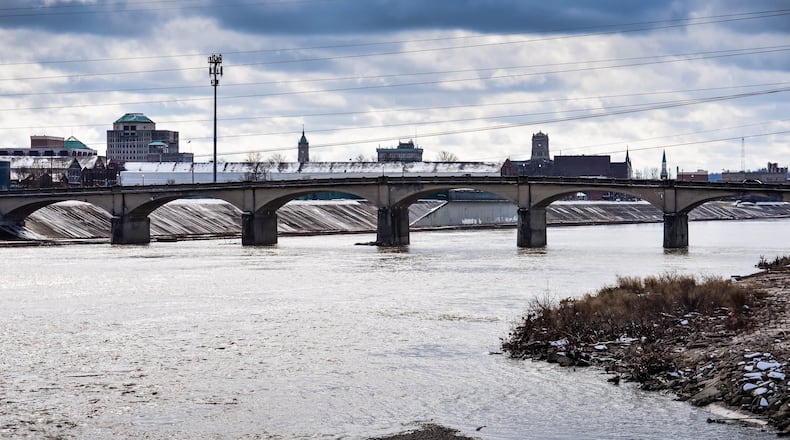The new highway likely will cost $75 million or more, officials estimated previously. It probably will include a four-lane boulevard-style road with speed limits of 45 mph or less. A new bridge across the Great Miami River will replace the existing, 100-year-old Black Street Bridge that is nearing the end of its usefulness to carry cars and trucks, although engineers have not yet limited weights of vehicles that cross it.
The proposed new roadway, almost 3 miles long if completely built, also will cross over the CSX railroad tracks to become only Hamilton’s third place where vehicles driving east-west do not have to stop for trains on the CSX lines. The other places are the congested High Street through downtown and the $32 million South Hamilton Crossing, which opened three years ago last week and carries Grand Boulevard over them, linking Ohio 4 with the area near Miami University’s Hamilton Campus and the city’s West Side.
The highway could have significant impacts to alleviate traffic congestion, particularly along the city’s main east-west highway of High and Main streets where traffic is heavy while commuters use it and at other times. Many residents and city officials fear that with the April 2022 opening of Spooky Nook Sports Champion Mill, which will attract 10,000 or more athletes and their families to the city on many weekends, traffic will worsen.
Some residents of Hamilton’s Fordson Heights area, and of Fairfield Twp., are concerned about what the highway could do to areas where they live. Some noted it would have significant impact on the Bonham Farm and on residents of Fairfield Township. Planners in November were urged to keep those people in mind.
The proposed new highway, while easing traffic along High and Main Streets, also could create heavier traffic in other parts of the city, including on the West Side. Northwest Washington Boulevard likely would become a busier thoroughfare than it is now, as drivers from places like Oxford may pass around the northern parts of Hamilton into Fairfield Twp., back into Hamilton, crossing the Great Miami River and the railroad tracks.
Major benefits seen in project
Dan Corey, director of the Butler County Transportation Improvement District, sees the project as completing work that the major construction of Ohio 129 began during the 1990s — better linking Hamilton, especially its West Side, to Interstate 75.
With that project, Ohio connected the interstate highway to the footstep of Hamilton,” Corey said.
North Hamilton Crossing will finish the Ohio 129 investment “by bringing 129 over the railroad track, over the river, to connect the West Side back to an interchange at I-75,” Corey said, putting Hamilton “into the 21st century ... for its economic activity.”
Two things that were “blessings” to Hamilton’s growth during the 19th and 20th centuries — the river and the railroads — are “now a hindrance of getting connectivity from the West Side of Hamilton to the interchange” with I-75, which is the city’s current most prominent transportation gift, he said.
About four dozen participants in a November “stakeholders” meeting were shown maps of several possible routes, which were marked Alternatives A through G. There actually are about a dozen possibilities, though, when some of those paths are combined with others.
While most Hamilton residents and commuters are most concerned about traffic congestion from commuters and Spooky Nook, Corey and Rich Engle, Hamilton’s director of engineering, point to two other significant aspects of the project:
- The aging Black Street Bridge, which might be converted to a pedestrian/bicycling pathway after it no longer carries vehicles, is about 20 years from requiring replacement unless there would be major structural work on it, Engle said consultants have estimated.
- Another overpass above CSX tracks would help vehicles avoid dangerous railroad crossings, Corey said.
Some are concerned
One person who’s concerned is Keith Reiring, a resident of the Fordson Heights area, which is separated from the rest of Hamilton’s North End neighborhood by Greenwood Cemetery. He’s concerned a route may disrupt the family friendly, quiet residential area where he lives.
“The growth and development of Hamilton has been exciting to watch over the years,” said Reiring, who had expressed concerns about the project’s routes and was included as a stakeholder to report back to his neighbors. “I reside in a wonderful neighborhood inside a great city.”
“I hope that all aspects are taken into account with the decisions and placements of any new roadways. My neighborhood is a great place to live and raise my family. I hope it will still remain that way.”
In addition to Alternatives A through G that are being considered, Reiring said he accepted planners’ suggestion and provided an alternative-route idea of his own, which he calls Alt Route 1. It would wend along the Hydraulic Canal of the Great Miami River and would end at Ohio 4 near North Eastview Parkway. It would affect fewer homes and the Bonham Farm, he said.
Also, some of the homes that would be in its path are in a floodplain, so are in danger of flooding, he said.
While transportation officials have drawn lines on the maps to show possible routes, Keith Smith, environmental coordinator for Ohio Department of Transportation District 8 notes those lines aren’t exact - only rough guesses, perhaps 100- to 500-feet wide, of where a roadway actually might go.
“I can’t tell you how many times I’ve talked to people in the public, they see a line on the map and are sure that’s a road,” Smith said. “They want to know why did we hit their grandmother’s house, or something. It’s just a representation of a study area.”
And yet, officials note it’s important to listen to people’s concerns.
“Each and every one of those alternatives impacts the community in a different manner,” Engle said. “And so we have to be very, very cautious and careful to make sure that we do the best planning we can, and to minimize impacts as much as possible.”
What’s next?
Here is what happens next:
- Officials envision two more “stakeholder” meetings in early 2022, at which time they probably will have fewer alternatives than now are under consideration.
- They then will schedule “public-input” meetings, where the general public is invited to comment on the process.
- By the end of 2022, officials hope to have a preferred alternative route.
- “At any point in the process, the general public can comment to Allen Messer,” Corey said. Messer can be reached at 513-785-7286 or Allen.Messer@hamilton-oh.gov.
About the Author


